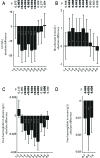Influence of centrifugation conditions on the results of 77 routine clinical chemistry analytes using standard vacuum blood collection tubes and the new BD-Barricor tubes
- PMID: 29187797
- PMCID: PMC5701775
- DOI: 10.11613/BM.2018.010704
Influence of centrifugation conditions on the results of 77 routine clinical chemistry analytes using standard vacuum blood collection tubes and the new BD-Barricor tubes
Abstract
Introduction: Although centrifugation is performed in almost every blood sample, recommendations on duration and g-force are heterogeneous and mostly based on expert opinions. In order to unify this step in a fully automated laboratory, we aimed to evaluate different centrifugation settings and their influence on the results of routine clinical chemistry analytes.
Materials and methods: We collected blood from 41 healthy volunteers into BD Vacutainer PST II-heparin-gel- (LiHepGel), BD Vacutainer SST II-serum-, and BD Vacutainer Barricor heparin-tubes with a mechanical separator (LiHepBar). Tubes were centrifuged at 2000xg for 10 minutes and 3000xg for 7 and 5 minutes, respectively. Subsequently 60 and 21 clinical chemistry analytes were measured in plasma and serum samples, respectively, using a Roche COBAS instrument.
Results: High sensitive Troponin T, pregnancy-associated plasma protein A, ß human chorionic gonadotropin and rheumatoid factor had to be excluded from statistical evaluation as many of the respective results were below the measuring range. Except of free haemoglobin (fHb) measurements, no analyte result was altered by the use of shorter centrifugation times at higher g-forces. Comparing LiHepBar to LiHepGel tubes at different centrifugation setting, we found higher lactate-dehydrogenase (LD) (P = 0.003 to < 0.001) and lower bicarbonate values (P = 0.049 to 0.008) in the latter.
Conclusions: Serum and heparin samples may be centrifuged at higher speed (3000xg) for a shorter amount of time (5 minutes) without alteration of the analytes tested in this study. When using LiHepBar tubes for blood collection, a separate LD reference value might be needed.
Keywords: centrifugation; diagnostic tests; pre-analytics; routine.
Conflict of interest statement
Potential conflict of interest: Janne Cadamuro received a personal fee as guest member of a Becton Dickinson Advisory board meeting.
Figures


Similar articles
-
The local clinical validation of a new lithium heparin tube with a barrier: BD Vacutainer® Barricor LH Plasma tube.Biochem Med (Zagreb). 2017 Oct 15;27(3):030706. doi: 10.11613/BM.2017.030706. Epub 2017 Aug 28. Biochem Med (Zagreb). 2017. PMID: 28900369 Free PMC article.
-
Barricor blood collection tubes are equivalent to PST for a variety of chemistry and immunoassay analytes except for lactate dehydrogenase.Clin Chim Acta. 2019 Sep;496:18-24. doi: 10.1016/j.cca.2019.06.013. Epub 2019 Jun 12. Clin Chim Acta. 2019. PMID: 31201816
-
Comparison of Three Blood Collection Tubes for 35 Biochemical Analytes: The Becton Dickinson Barricor Tube, Serum Separating Tube, and Plasma Separating Tube.Ann Lab Med. 2021 Jan;41(1):114-119. doi: 10.3343/alm.2021.41.1.114. Epub 2020 Aug 25. Ann Lab Med. 2021. PMID: 32829587 Free PMC article.
-
Quality of plasma samples and BD Vacutainer Barricor tubes: Effects of centrifugation.Clin Chim Acta. 2018 Aug;483:271-274. doi: 10.1016/j.cca.2018.05.018. Epub 2018 May 10. Clin Chim Acta. 2018. PMID: 29753681
-
Comparison of Barricor™ vs. lithium heparin tubes for selected routine biochemical analytes and evaluation of post centrifugation stability.Biochem Med (Zagreb). 2018 Jun 15;28(2):020902. doi: 10.11613/BM.2018.020902. Epub 2018 Apr 15. Biochem Med (Zagreb). 2018. PMID: 29666561 Free PMC article.
Cited by
-
Fibrin clot interference in a human chorionic gonadotrophin assay causing a false Down syndrome screening result.Biochem Med (Zagreb). 2023 Feb 15;33(1):011001. doi: 10.11613/BM.2023.011001. Biochem Med (Zagreb). 2023. PMID: 36817855 Free PMC article.
-
Comparative study of chemical pathology sample collection tubes at the largest hospital in South Africa.J Med Biochem. 2021 Sep 3;40(4):358-366. doi: 10.5937/jomb0-27216. J Med Biochem. 2021. PMID: 34616225 Free PMC article.
-
Evaluation of an alternative centrifugation protocol for reducing total turnaround time.Adv Lab Med. 2024 Nov 21;6(1):108-112. doi: 10.1515/almed-2024-0170. eCollection 2025 Mar. Adv Lab Med. 2024. PMID: 40160406 Free PMC article.
-
Plasma-based S100B testing for management of traumatic brain injury in emergency setting.Pract Lab Med. 2021 May 12;26:e00236. doi: 10.1016/j.plabm.2021.e00236. eCollection 2021 Aug. Pract Lab Med. 2021. PMID: 34041343 Free PMC article.
-
Biochemical, immunochemical and serology analytes validation of the lithium heparin BD Barricor blood collection tube on a highly automated Roche COBAS8000 instrument.Acta Biomed. 2020 Mar 19;91(1):47-55. doi: 10.23750/abm.v91i1.9195. Acta Biomed. 2020. PMID: 32191654 Free PMC article.
References
-
- Guder W, Narayanan S, Wisser H, Zawta B, editors. What has to be done on specimen arrival? - specimen processing, centrifugation, distribution. In: Guder W, Narayanan S, Wisser H, Zawta B eds. Diagnostic samples: From the patient to the laboratory. 4th ed. Weinheim: Wiley, 2009. p. 44-5.
Publication types
MeSH terms
Substances
LinkOut - more resources
Full Text Sources
Other Literature Sources
Research Materials
Miscellaneous

